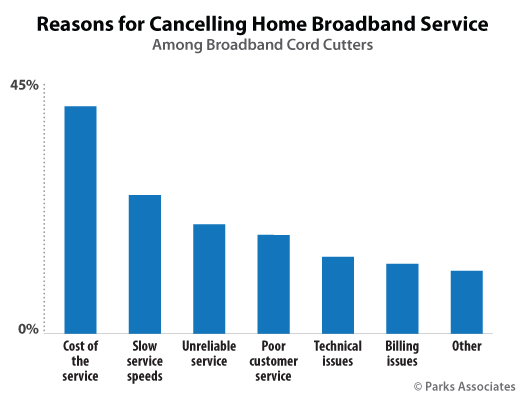Mobile substitution has been a huge driver of revenue, market share and profit margin change in the consumer connectivity industry. Long distance revenues, voice revenues have been the big obvious examples.
The next areas to watch are video entertainment and internet access.
Parks Associates, for example, reports more than 12 million U.S. households have cancelled their home broadband service and use only mobile broadband for internet access.
That equates to more than 15 million households using mobile broadband service exclusively. Some three million of those households that have never had a home internet subscription, and have been mobile-only from the start.
Other estimates of mobile-only internet access support that observation. As much as 20 percent of U.S. households were mobile only for internet access in 2017, Deloitte estimated, with take rates correlating with household income. Mobile-only behavior occurred in 15 percent of richer homes and 20 percent in poorer households.
The new wrinkle is 5G for fixed wireless, which some proponents suggest could add another 15 percent to 20 percent market share for mobile operators, with share taken directly from fixed network suppliers.
Over the top application substitution has been the other big driver of revenue and profit margin change, diminishing service provider revenues and profits from text messaging, long distance calling and voice calling.
In the connectivity business, the "mobile substitution" trend has occurred in phases, and affected a wider range of products over time.
Mobile voice supplanted fixed voice as the preferred consumer use case. "Mobile substitution" for voice has been a global trend since the advent of 2G networks. In fact, mobile is the only sort of ubiquitous network in most parts of the world. But that now might become an issue for internet access as well.
“I will say over time--a three to five year time horizon--unequivocally 5G will serve as a broadband, a fixed broadband replacement product,” former AT&T CEO Randall Stephenson said. “I am very convinced that that will be the case.”
“Back in the 90s everybody was saying wireless would never serve as a substitute for fixed line voice because there wasn't sufficient capacity,” Stephenson said. “Well it is a substitute for voice.”
Mobile messaging displaced voice. Mobile social media displaced fixed modes. Mobile turn-by-turn navigation displaced dedicated GPS devices and maps.
Mobile phones displaced watches, cameras, music players and flashlights. Mobile entertainment video is encroaching on fixed modes of viewing (TV sets, PC or tablet screens).
Mobile internet access, which began to find niches in the 3G era, found many more use cases in the 4G era (both for home broadband replacement and on-the-go access). In developing regions, mobile internet access is the preferred form of access.
In the 5G era, we will see a big test of fixed wireless and mobile wireless as a substitute for fixed network access in a wider range of settings. No later than 6G, we might routinely be using mobile access as a substitute for home broadband. The key enabling trends are higher routine speeds and some shifts of pricing plans and consumer behavior.

source: Parks Associates
Cost and speed are cited by cord cutters as reasons for ditching fixed network internet access. Obviously that behavior could change if cabled network speeds are upgraded and cost becomes more appealing.
At least initially, it can be hypothesized that mobile substitution will be most appealing for households with modest bandwidth requirements, as that is where the best match of fixed wireless speeds and pricing with customer demand.
If the average U.S. household consumes 269 GB per month, according to OpenVault, and the average number of people per household is 2.5, than per-user consumption is about 108 GB per month.
If a typical household spends $66 for fixed internet and between $40 and $60 a month for mobile data, we can roughly estimate the breakeven point where going all-mobile for internet access costs no more than what already is spent for mobile and fixed internet access, ignoring a bit of hassle factor for doing so.
Assume per-user mobile data costs $50 a month, while per-household fixed data costs $70 a month, and about $28 per user in each household. For a multi-user household of an average 2.5 users, that implies something like $78 per user for an all-mobile approach.
It’s a rough estimate, but that implies usage allowances currently set at about 110 GB, priced at about $80, would be competitive offers for many users, and allow substitution for fixed internet access.
